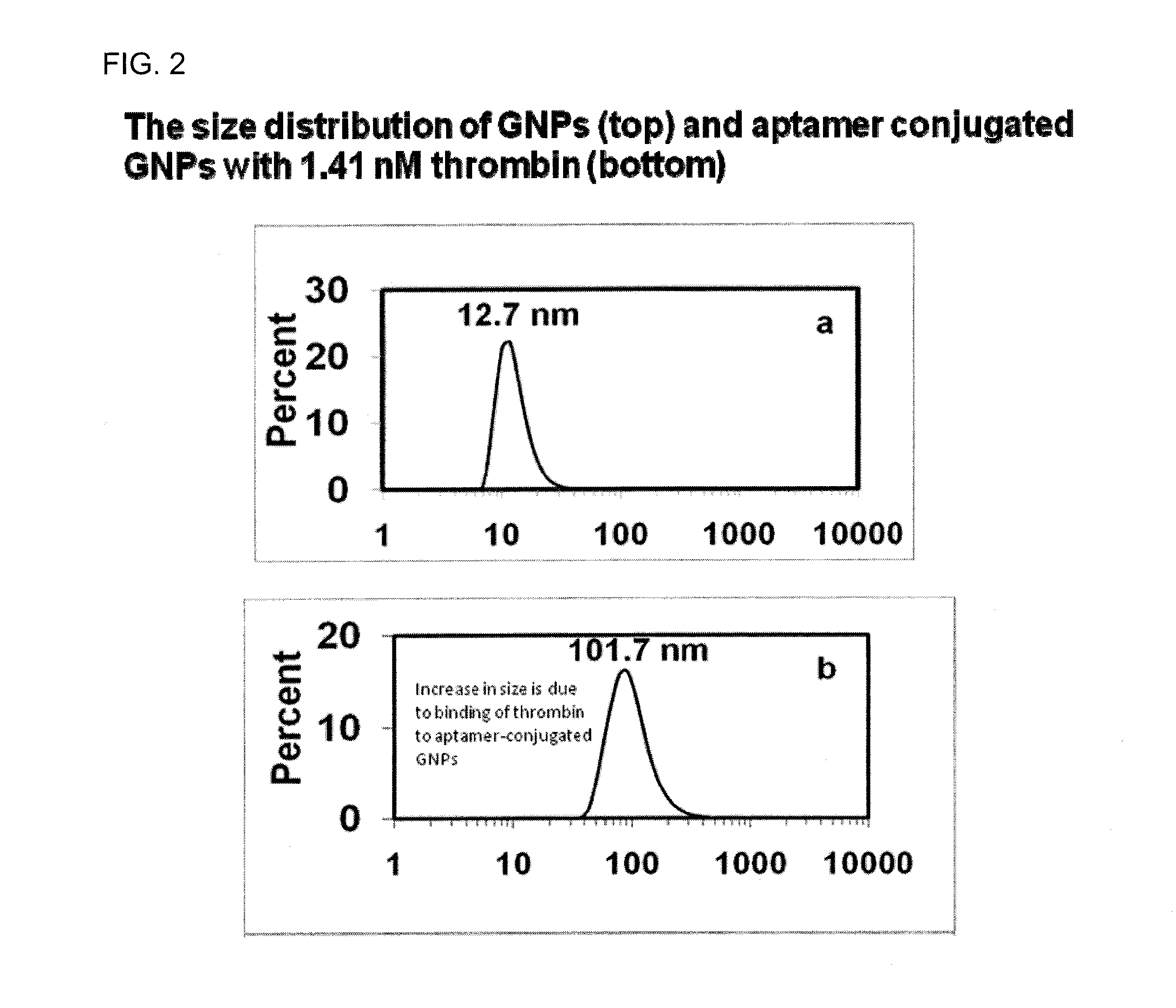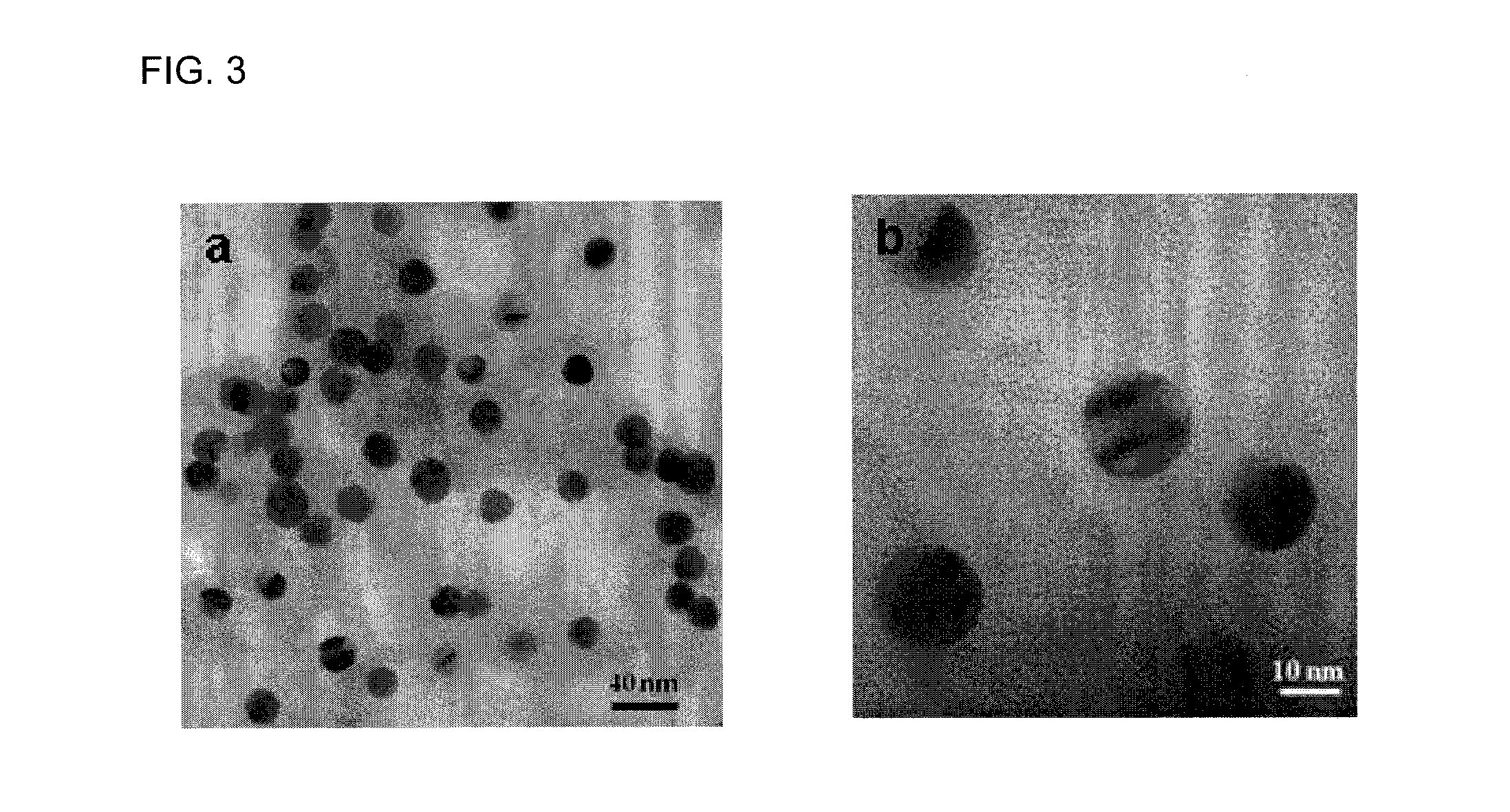Aptamer-Based Device For Detection Of Cancer Markers And Methods Of Use
a technology of cancer markers and aptamer strips, applied in the field of aptamer-based strips, can solve the problems of inability to detect cancer markers in the native environment, both methods are sensitive to the solution environment, and both fluorescence-based methods have significant limitations in analyzing proteins in their native environmen
- Summary
- Abstract
- Description
- Claims
- Application Information
AI Technical Summary
Benefits of technology
Problems solved by technology
Method used
Image
Examples
example 1
Preparation of Strip as the Platform for the Binding of Aptamer-Conjugated Nanoparticles to Marker Proteins
[0053]The well known lateral flow format was utilized to fabricate the strip. Unlike traditional lateral flow strips used in antibody-based assay, this strip combined traditional lateral flow kit design with contemporary fluorescent nanoparticle labels and aptamer assays. Moreover, unlike traditional lateral flow strips that incorporate several membranes, the instant strip used only one membrane that was made of a large-pore single layer hydrophilic material that was non-protein binding in nature. This material fulfilled all of the required functionalities of the components of the traditional lateral flow device, namely, as a sample pad, a conjugate pad, a membrane, and an adsorbent pad. Because the material used to build the membrane did not bind to proteins, a different strategy called “laying down boulders in the stream” was used to construct the test and control lines. Brie...
example 2
Binding of Aptamer-Conjugated Nanoparticles to Marker Proteins
[0054]Dithiothreitol (DTT), thrombin from bovine plasma, and bovine serum albumin (BSA) were purchased from Sigma Aldrich (St Louis Mo.). Lysozyme was purchased from Sigma-Aldrich (St. Louis, Mo.). Thiolated thrombin with sequence 5′-SH-(CH2)6-TTTTTTTTTTGGTTGGTGTGGTTGG-3′ and thiolated lysozyme aptamer, 5′- / 5thioMC6-D / ATC TAC GAA TTC ATC AGG GCT AAA GAG TGC AGA GTT ACT TAG-3′ were purchased from Integrated DNA Technologies (Coralville, Iowa). Hydrogen tetrachloroaurate (III) trihydrate (HAuCl4.3H2O) was obtained from Fisher Scientific (Fair Lawn, N.J.). Sodium citrate was obtained from Spectrum Chemical Corp (New Brunswick, N.J.). Gel filtration columns (NAP-5) was purchased from GE Healthcare Bio-Sciences Corp (Piscataway, N.J.). DLS Spectroscopy was performed on a Malvern Nanozetasizer (ZS90). The DLS spectrometer was operated at 25° C. with the detector angle at 90°, incident laser wavelength of 633 nm and 4 mW laser p...
example 3
Aptamer Constructs for Selective Target Detection
[0069]In order to detect proteins in a sample using a lateral strip, an oligonucleotide construct was designed and synthesized which incorporated two known aptamer sequences that bind thrombin and ATP, respectively. As shown in the FIG. 6, the oligonucleotide had both a thrombin binding region and an ATP binding region, and these two binding regions were separated by an inter-aptamer region of several nucleotides in length. In addition, the sequences at the 5′ and 3′ end of the oligonucleotide construct were complementary to each other such that the oligonucleotide would fold into a hairpin structure as shown in FIG. 6.
[0070]In construction A, two reporters, fluorescein and Cy3, were conjugated to the 5′ terminus and to the inter-aptamer region, respectively. Fluorescein and Cy3 were known to be a fluorescent FRET pair. Changes in FRET were monitored after separate or sequential addition of thrombin and ATP targets to construct A. FRE...
PUM
| Property | Measurement | Unit |
|---|---|---|
| OD | aaaaa | aaaaa |
| diameter | aaaaa | aaaaa |
| size | aaaaa | aaaaa |
Abstract
Description
Claims
Application Information
 Login to View More
Login to View More - R&D
- Intellectual Property
- Life Sciences
- Materials
- Tech Scout
- Unparalleled Data Quality
- Higher Quality Content
- 60% Fewer Hallucinations
Browse by: Latest US Patents, China's latest patents, Technical Efficacy Thesaurus, Application Domain, Technology Topic, Popular Technical Reports.
© 2025 PatSnap. All rights reserved.Legal|Privacy policy|Modern Slavery Act Transparency Statement|Sitemap|About US| Contact US: help@patsnap.com



